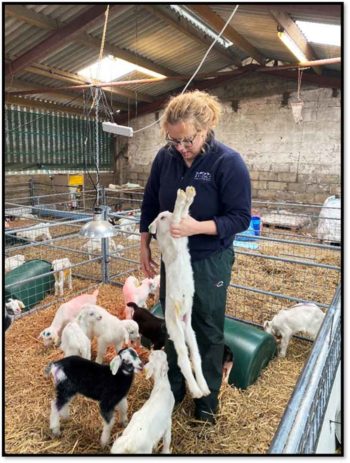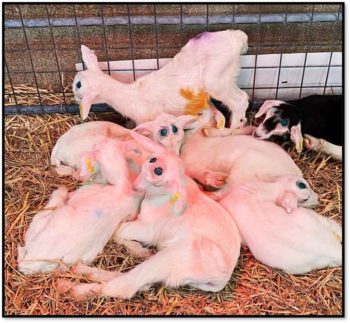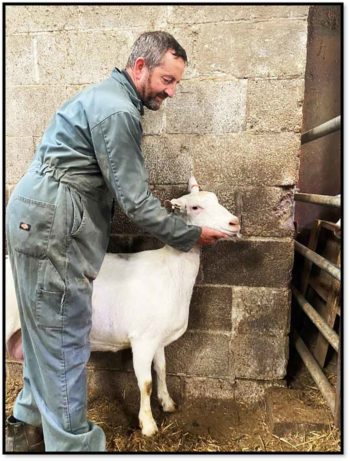26 Aug 2021
David Harwood BVetMed, FRCVS summarises topics discussed at the Goat Veterinary Society spring meeting, which was held online again.

Figure 1. Try to avoid antibiotic use in neonatal kids by sound management.
The Goat Veterinary Society (GVS) held its spring meeting virtually again in June, but hopes to have a real face-to-face meeting this autumn, with fingers firmly crossed.
A good number of delegates logged on live to the lectures – with delegates from New Zealand, Finland and Estonia in addition to the UK. This is one advantage with this medium, as it does bring in other points of view during the Q&A sessions. All three lectures were recorded, and will be uploaded to the GVS website and made available to the membership who did not login live.
The first speaker was Fiona Lovett, an RCVS Knowledge farm champion, who introduced Farm Vet Champions (FVC) – a major collaborative project spearheaded by the charity RCVS Knowledge that has, at its heart, the mantra “Plan, Prevent, Protect” in terms of ensuring healthy farm livestock and, hence, reducing the need for antibiotic use.
It was demonstrated in the 2014 O’Neill report that by 2050, the number of human deaths due to antimicrobial resistance (AR) will outnumber deaths from cancer. At a predicted 10 million global deaths a year, the scale of the issue will utterly dwarf the impact of our current world covid pandemic.
For today’s online delegates, routine hospital procedures for family members have not previously been a cause for undue concern, but action is needed now to slow the current trend in AR. The project aims to reduce the past reliance on prophylactic antibiotic for routine problems, such as neonatal mortality or post-kidding diarrhoea, by improving general stockmanship and animal husbandry (Figure 1).

Nationally, we have already made huge and significant progress in reducing levels of antibiotics used in farm animals – with a 45 per cent reduction over five years – although this progress has been largely evidenced in the more tightly integrated sectors such as pigs and poultry, which have good herd-level data and are predominantly serviced by species-specific vets. In the ruminant sectors, herd-specific data is sparse and widely variable.
FVC is a project aimed at all vets who have contact with food-producing animals and their owners. The GVS, BCVA, Sheep Veterinary Society, Pig Veterinary Society and British Veterinary Poultry Association have provided high-quality species-specific technical CPD training, and different behaviour and communication experts have provided short presentations on how to motivate behaviour change.
Additionally, key sessions are provided by the VMD and NOAH on the legalities and practicalities of our use of veterinary medicines. The GVS has produced an online training module that is available (with other species-specific modules) at www.rcvsknowledge.org/farm-vet-champions
The next recorded presentation was from GVS treasurer Bryony Kendall of Tyndale Farm Veterinary Practice. She began by describing goats as fun, cheeky, naughty and in your face, and at times can be “annoying” to work with.
Kids less than 15kg are best picked up by placing your hands under the ribcage, although they can be carried for short distances by holding them by their front legs (Figure 2). Kid areas should be warm and not overcrowded, with areas to “snuggle up and hide away”.
In the UK, kids can only be disbudded by a vet under anaesthesia and placed back in a warm, clean pen afterwards (Figure 3). Kids will literally “mob you” when attempting any procedure – so it is always best to undertake such a procedure outside the pen away from inquisitive litter members.

Handling goats between two and six months of age is the “fun zone” as they are almost totally un-herdable. They can escape easily, and attempts should be made to reduce their available space and escape routes. Environmental enrichment is important at this age, with things to climb on and jump off, things to push around such as footballs and plenty of space to play.
Handling adult goats is hampered by their natural inquisitiveness, literally mobbing anyone in the pen doing anything. In commercial milking herds, they are generally more used to being handled and can be more easily herded.
Handling systems should be narrow, and just wide enough for one goat to pass through at a time. If a need to move them forward exists then a hand on the hind end or a gentle pat will help; no tail twisting or udder slapping should be tolerated.
Sticks can be used for waving, making the handler “wider”, but should never be used to hit the goats with. Dogs should not be used. If attempting to catch an adult goat, this is best achieved by catching under the chin, not a front or back leg. Restraint is generally easy, and they will stand against something if held under the chin, with a knee against the underside; ears and beards should not be held for restraint (Figure 4).
Foot trimming may be necessary in commercial milking herds fed on concentrate and housed on deep litter. The procedure is a skilled one and can be carried out with the goat in a standing position, or in a modified sheep turnover crate.

The final speaker of the day was the author, GVS senior vice-president and ex-APHA. He began by emphasising the importance of knowing the individual variation in faecal consistency between goats. Most, but not all, will produce pelleted faeces daily, but in some it may be “normal” for their faeces to be pastier – and it is a change to more liquid consistency that is key to a diagnosis of diarrhoea.
It can be categorised as either infectious or non-infectious, or by age as neonatal, growing kid or adult.
The most important cause of diarrhoea in adult goats is enterotoxaemia caused by Clostridium perfringens type D, which causes an enterocolitis. In severe cases, goats can die within a 24-hour period from an overwhelming toxaemia.
More typically, affected goats show diarrhoea of increasing severity, with blood and mucous often evident (Figure 5).
Gut damage can be severe, and treatment often disappointing. Prevention is key to this condition, avoiding potential trigger factors such as sudden diet changes, and ensuring a clostridial vaccination programme is in place. The speaker suggested a four-in-one vaccine as the vaccine of choice – but with the added need to ensure a booster dose be given at least every 6 months (not 12 months as with other ruminants).
Other causes included parasitic gastroenteritis (PGE), with the reminder that goats produce poor age-dependent resistance to nematode parasites, such that clinical PGE can be encountered in goats of six or seven years of age, even if exposed previously.
Anthelmintic use was discussed – emphasising the importance of using an increased dose rate to those quoted for sheep when using anthelmintics under cascade principles.

Separate worm control programmes for goats and other ruminant species need to be developed when running together on a smallholding, for example. Johne’s disease was discussed, but in the speaker’s view, diarrhoea is not a common feature until the disease is in the later clinical stages.
Other infectious causes included Salmonella (comparatively rare), yersiniosis and listeriosis. Non-infectious causes discussed include acidosis associated with rumen carbohydrate overload, and some known poisonous plants such as acorns and oak leaves, rhododendron (in addition to the more dramatic presentation of vomiting) and foxgloves.